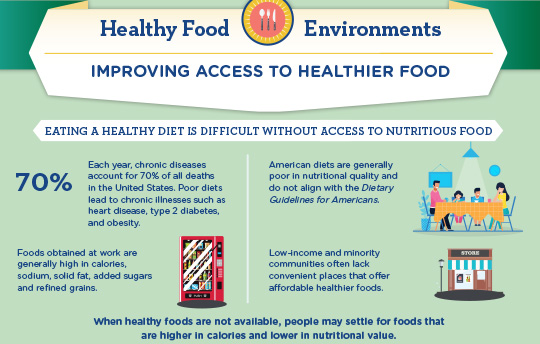 People get most of their food from either food retail venues (e.g., grocery stores, corner stores, and farmers’ markets), or from food service venues (e.g., restaurants, childcare facilities, schools, and hospital and worksite cafeterias). Having affordable, healthy food in these settings allows people to make healthier choices. When healthy foods are not available, people may settle for foods that are higher in calories and lower in nutritional value.
People get most of their food from either food retail venues (e.g., grocery stores, corner stores, and farmers’ markets), or from food service venues (e.g., restaurants, childcare facilities, schools, and hospital and worksite cafeterias). Having affordable, healthy food in these settings allows people to make healthier choices. When healthy foods are not available, people may settle for foods that are higher in calories and lower in nutritional value.
“People who live in areas with the least access to nutritious foods usually have the highest rate of chronic conditions,” said Belkys Gomez, REACH program coordinator for The Wellness Coalition. “Increased access to healthy foods can give people a fighting chance in preventing or managing most chronic conditions.”
TWC Tackles River Region Food Systems
The Wellness Coalition (TWC) has been working to increase access to healthy foods throughout the River Region.
Implemented strategies include:
- Partnering with churches to implement health ministry programs and nutritional policy changes
- Providing technical assistance and support for local food banks/pantries on ways to create or enhance nutrition policies and establish nutrition standards.
- Training agencies and businesses on the Munch Code, a color-coded labeling program designed to make it easier for people to choose healthier snacks
- Increasing public awareness about ways to eat healthier and the benefits of eating healthy
- Alerting consumers to nearby locations where healthy foods can be acquired
More Strategies for Healthy Food Environments
- Worksites can promote health and wellness in the workplace by implementing food service guidelines, such as those developed for federal worksites.
- Hospitals can offer healthier choices to their patients, employees, and visitors.
- Early care and education programs can use best practices to increase consumption of healthy food and beverages and to increase breastfeeding rates. Childcare centers can also develop action plans and policies that promote healthy eating.
- Schools can offer more healthy food and beverage options, and encourage students to eat foods that meet dietary recommendations for fruits, vegetables, whole grains, and nonfat or low-fat dairy products.
- Restaurants can implement menu labeling, adopt nutrition standards for children’s meals, and promote healthier meals and food items.
TWC Food Pantry & Food System Partners
- Helping Hands Food Ministry
- Open Door Worship Center
- Stone Tank Antioch Missionary Baptist Church
- Sun Does Shine Food Pantry (The Inspired Child Project)
